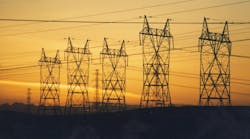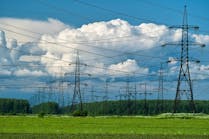Study Helps Map Out Road Ahead for U.S. Electricity System
Earlier this quarter, the Obama Administration released the second installment of the interagency Quadrennial Energy Review (QER 1.2), “Transforming the Nation’s Electricity System”. The new report focuses on the nation’s electricity system, from electricity generation to end uses, and addresses the need for improvements in that system. Jan. 9 was the third anniversary of the Presidential Memorandum that initiated the QER. Since that time, the QER team has produced two landmark installments and made a significant impact on energy policy.
This second installment of the QER builds on QER 1.1 — “Energy Transmission, Storage, and Distribution Infrastructure”, which was released in April 2015. QER1.1 made 63 recommendations, which DOE and its partners have been actively implementing. As detailed in the recent “Report Card,” 29 of the recommendations have already been fully implemented and an additional 21 are currently underway. Many of the recommendations requiring legislative action have been taken up by Congress, with 21 of the legislative recommendations now fully or partially reflected in Federal law. DOE will work with Congress and other agencies to achieve similar positive impact based on the recommendations from QER1.2
Modernizing the nation’s electricity system is a strategic imperative. Reliable and affordable electricity provides necessary energy services for consumers, business, and national defense and underpins virtually every sector of the modern U.S. economy. This first-of-its-kind review of the electricity system provides analysis-based recommendations on how the federal government can most effectively work with states, localities, industry, and other stakeholders to meet future electricity needs, fully realize America’s economic potential, and secure the United States as a global leader in clean-energy innovation.
Here’s how:
Protect the Electricity System as a National Security Asset. The QER analyzes the interactions and interconnections that characterize the electricity system, as wells as the risks the system faces and concludes that the electricity system should be treated as a National security asset. The QER also provides recommendations to align investments and interests in support of the overarching National interest in electricity system security against threats both natural and manmade. The report recommends:
- Amending the Federal Power Act, including new authorities under the FAST Act, to clarify and affirm that the electricity system—from bulk power to distribution—is a national security asset, making its protection a fundamental Federal responsibility.
- Adopting integrated electricity-security planning and standards on a regional basis.
- Assessing interdependencies of natural gas/electricity system infrastructure for cyber security protection to determine whether additional measures are needed to protect the electricity system.
Maximize Economic Value and Consumer Equity. Consumer options for electricity services and energy efficiency have grown dramatically, enabled in part by the smart grid and the Internet of Things, and supported by significant consumer demand for a range of new services. Consumers can now both produce and consume power through distributed generation technologies and an advanced distribution infrastructure, a significant change in the customer-utility relationship. Advances needed to increase economic value and consumer equity in this context include:
- Increasing Federal support for state efforts to quantitatively value and incorporate energy efficiency, demand response, distributed storage, and distributed generation into resource planning.
- Evaluating the potential to improve incentives and programs to cut electricity bills for low- and moderate-income households.
- Supporting electrification and opportunities for economic development by advancing energy technologies on tribal lands.
- Leveraging electric-utility broadband build-out to expand public broadband access in rural areas.
Build a Clean Electricity Future. Reducing greenhouse gas and other harmful emissions is a key imperative for the power sector and builds on the success of environmental policy in reducing adverse public health and environmental impacts from electricity generation throughout the 20th century. Ensuring a clean and flexible electricity system will require continually reducing the cost and improving the environmental performance of energy technologies. Achieving these goals will require a number of actions, including:
- Significantly increasing Federal investment in clean electricity Research Development & Demonstration and implementing regional, clean-energy-innovation partnerships.
- Analyzing financing for advanced large-scale generation, while also expanding tax incentives for renewable electricity, electric vehicles, and energy efficiency.
- Extending the timeframe and total capacity allowed under the production tax credit for nuclear power generation and providing tax credits for carbon capture, utilization, and sequestration.
- Reducing the electricity intensity of newly constructed residential and commercial buildings by at least 50 percent relative to typical, present-day, new building construction by 2030.
- Assessing business model inequities associated with Federal electricity financial incentives to include an examination of the usage of tax credits for tax-exempt entities.
Ensure Reliability, Security, and Resilience. Traditional electricity system operations are evolving that can enable a more dynamic and integrated grid, creating both enormous opportunities and the potential for new risks and vulnerabilities. The emerging threat environment, particularly with respect to cybersecurity and increases in the severity of extreme weather events, poses challenges for the reliability, security, and resilience of the electricity sector, as well as to its traditional governance and regulatory regimes. Key steps needed to minimize these risks include:
- Materially expanding existing Federal programs to demonstrate the integration and optimization of distribution-system technologies.
- Providing incentives for energy storage.
- Enhancing coordination between energy-sector information-sharing and analysis centers and the intelligence communities to synthesize threat analysis and disseminate it to industry in a timely and useful manner.
- Supporting grants for small utilities facing cyber, physical, and climate threats.
- Accounting for emerging threats during reliability planning.
- Providing funding assistance to enhance analytical capabilities in state public utility commissions.
Invest in a Modern Workforce. A skilled workforce that can build, operate, and manage this modernized grid infrastructure is essential for the 21st century electricity system. Building a dynamic electricity workforce will require support from the Federal Government, including by:
- Strengthening Federal and regional efforts focused on electricity workforce development and transition assistance.
- Supporting cyber-physical systems (CPS) curriculum, training, and education for grid modernization and cybersecurity.
- Enhancing and aligning skills-based training and electricity-sector workforce development.
Enhance Electricity Integration in North America. Leaders in the United States, Canada, and Mexico have publicly and repeatedly affirmed support for increasing energy integration, and there is a general understanding across the continent that the benefits of cross-border electricity trade can be improved with deeper system integration. A subset of the policies needed to accomplish this goal include:
- Advancing North American grid security through sharing of best practices and exploration of potential future cooperation on grid security issues.
- Facilitating the permitting of cross-border transmission-facilities by expanding the Regulatory and Permitting Information Desktop (RAPID) Toolkit.
- Increasing North American clean-energy and technical coordination and enhancing cooperation on energy information exchange across North America.
The full report, details on the process for stakeholder input, and the related analyses are available at energy.gov/qer.


